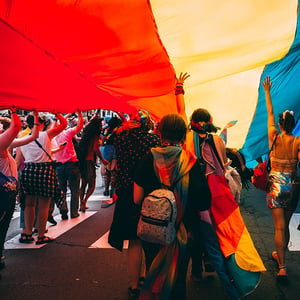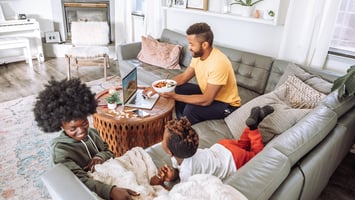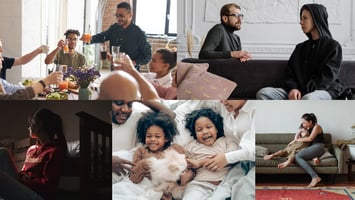As we emerge from the worst of the COVID-19 crisis, it’s time to raise awareness about some of the less-talked-about consequences of the pandemic. Last month, we explored how and why we need foster care parents now more than ever. But this time, against the backdrop of Pride Month, we thought it fitting to focus on how COVID-19 has affected LGBTQ+ foster youth.
COVID-19’s Overall Impact On The LGBTQ+ Community
Research provided by the Kaiser Family Foundation indicates that LGBTQ+ individuals of all ages have been disproportionately impacted by the pandemic:
![]() Limited data from early in the pandemic suggested that they had a higher risk of more severe COVID-19 outcomes because they were more likely to have comorbidities.
Limited data from early in the pandemic suggested that they had a higher risk of more severe COVID-19 outcomes because they were more likely to have comorbidities.
![]() LGBTQ+ individuals also were at a higher risk of job loss and economic hardship than non-LGBTQ+ adults.
LGBTQ+ individuals also were at a higher risk of job loss and economic hardship than non-LGBTQ+ adults.
![]() Nearly three-quarters of self-identified LGBTQ+ individuals reported that the pandemic has negatively impacted their mental health.
Nearly three-quarters of self-identified LGBTQ+ individuals reported that the pandemic has negatively impacted their mental health.
And as the Psychiatric Times points out, the forced social isolation of this past year may have been especially difficult for young people in the community. For example, “They may be quarantining with rejecting family-members and losing contact with supportive social networks.”
It’s this latter issue — the social and mental health consequences — that resonated with us the most. So many in foster care, LGBTQ+ or otherwise, have had to grapple with the double trauma of disruptions in their home life and social isolation. And LGBTQ+foster youth likely have faced additional challenges.
We sat down with Amber Salzer and Nancy Gutierrez from the Washington State Department of Children Youth and Families (DCYF) to learn more about this issue as it relates to Washington State and how we can help. Below are the key takeaways.
This Underscores The Need For Greater Representation
The idea that LGBTQ+ foster youth are particularly vulnerable to the negative effects of social isolation isn’t new. It’s an existing problem — one that the Psychiatric Times implies is partly due to overwhelmed agencies that aren’t able to adequately address inequities or provide critical services. The pandemic has merely exacerbated that issue.
One of the article’s proposed solutions is to increase LGBTQ+ representation in leadership bodies. This will help raise awareness of the challenges LGBTQ+ youth face and will increase the likelihood that leaders will advocate for and prioritize getting these children the support they need.
Those in leadership roles, after all, set the example for everyone else — that is, the ideals and priorities they emphasize trickle down to others. Nancy Gutierrez, for instance, explained that at DCYF, they made it a point to integrate racial equity and social justice into their strategic plan so that those ideals are incorporated in everything they do. There are also certain policies in place, such as Policy 6900 (Supporting LGBTQ+ Identified Children and Youth), that provides guidance to staff regarding how to appropriately support and place LGBTQ+ children and youth.
Having Supportive And Welcoming Foster Parents Is Key
The best thing current and potential foster parents can do is build awareness of the LGBTQ+ culture.
Most foster parents understand that the children in their care will come from all parts of the state of Washington and all different cultures. But being welcoming and open is different from truly understanding how to care for and support foster children who may not look like you, who may not have the same sexual preference as you do, or who may identify as a different gender. So, learning as much as they can about the issues LGBTQ+ individuals face is critical.
In particular, Nancy suggests that these three steps can make a big impact:
- Attend trainings and learn all they can about the LGBTQ+ culture
- Use the names and pronouns used by the youth in their care
- Hang welcome signs, even if it’s simple like “All are welcome” or a rainbow
Take Advantage Of Local Resources
Foster families aren’t on their own in learning the best ways to support the LGBTQ+ youth in their care either. There are plenty of local resources that can help foster parents get started and connect LGBTQ+ youth to welcoming and supportive communities. DCYF has resources and support programs that foster parents and LGBTQ+ youth can use. And both foster parent and child may also want to check out:
- PFLAG: Short for Parents, Families, and Friends of Lesbian and Gays, PFLAG is a well-established, national organization with local chapters all over the country, including in Washington State.
- Stonewall Youth: a Washington-based, youth-led organization that supports LGBTQ+ youth through a variety of programs, including peer support groups, advocacy and mentorship, social events, and more.
- Pizza Klatch: a Thurston County-based support group for LGBTQ+ youth and their allies. Group meetings take place during lunchtime in classrooms at participating high schools.
The pandemic has taken its toll on everyone, but especially our foster youth. The worst of the virus may be behind us. But there is still quite a bit of work to do to ensure our youth, especially those who identify as LGBTQ+, get the support they need to heal.
Take the first step and explore whether foster parenting is right for you. Enroll in our new eight-part webinar course on foster parenting, which covers everything from how you become a licensed foster parent to the complexities and everyday joys you will encounter while parenting. Click here to register now.




